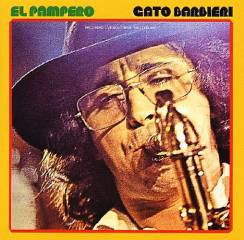Gato Barbieri – El Pampero - Live In Montreaux 1971
Gato Barbieri – El Pampero - Live In Montreaux 1971

1 El Pampero 13:46
2 Mi Buenos Aires Querido 6:20
3 Brasil 10:03
4 El Arriero 12:02
5 El Gato 15:22
Alto Saxophone, Conductor, Arranged By – Oliver Nelson (tracks: 5)
Bass – Chuck Rainey (tracks: 1 to 4), Ron Carter (tracks: 5)
Bass Clarinet – Danny Bank (tracks: 5)
Berimbau, Percussion – Nana Vasconcellos (tracks: 1 to 4)
Congas – Sonny Morgan (tracks: 1 to 4)
Drums – Bernard Purdie (tracks: 1 to 5)
Flute [Alto], English Horn – Romeo Penque (tracks: 5)
Flute, Flute [Alto] – Phil Bodner (tracks: 5)
Guitar – David Spinozza (tracks: 5)
Percussion – Airto Moreira (tracks: 5)
Piano – Hank Jones (tracks: 5), Lonnie Liston Smith (tracks: 1 to 4)
Tenor Saxophone – Gato Barbieri (tracks: 1 to 5)
In June 1971 Gato Barbieri was on the verge of becoming one of jazz’s new stars. He had just recorded “Fenix”, his second album for Flying Dutchman, which saw him temper his previously experimental sound, putting more emphasis on the rhythms and folk music of South America and less on the avant-garde. “Third World”, his debut for the company, had started the process, prompting his recognition as a leader. Bob Thiele, the label’s owner, decided to build Flying Dutchman Night at that year’s Montreux Jazz Festival around Barbieri. Recorded on the Festival’s state-of-the-art equipment, the event and resulting album, “El Pampero”, led to his breakthrough as an artist.
Montreux was a great place to showcase talent. Claude Nobs had started the Festival in 1967, and 1971 was the year it became truly international, with Polydor, Atlantic and Flying Dutchman all recording artists at the event. Flying Dutchman Night included sets from Barbieri, Oliver Nelson, Leon Thomas, Larry Coryell and Eddie Vinson. Nelson’s big band opened the evening, with Barbieri playing an important role in ‘Swiss Suite’, written specially for the occasion. The performance went down a storm, and Barbieri went off to wait for his own set, which took place in the small hours of the morning. If the audience was tired, they were soon invigorated by the performance. Drummer Bernard Purdie returned for his third set of the night, with bassist Chuck Rainey, pianist Lonnie Liston Smith and percussionist Naná Vasconcelos completing Barbieri’s ensemble.
The performance was described by Rolling Stone magazine as stealing the show. The music revealed Barbieri at the top of his game, caught somewhere between his earlier free self and his less frenetic, more accessible future. The use of the music of his homeland – rather than an American musician using foreign rhythms – was an important moment in the history of jazz. The set showed that a non-US musician could take jazz forward. Listening to “El Pampero” reveals what a thrill it must have been to be in the audience. It is very rare to be present when an artist finds their wings: the point at which they go from being one of the crowd to becoming a star. It happened for Gato Barbieri at Montreux in 1971, the moment captured on this disc. --- Dean Rudland, acerecords.co.uk
This record chronicles a flavorful and unforgettable night during a live show recorded in Montreux, Switzerland. Gato Barbieri leads his fantastic group of musical friends with hurricane-like flair on his tenor sax. At times surreal and mind-boggling, Barbieri shows just how far one can let the music go to break the borders of jazz, sending his music into fresh and uncharted territory. Barbieri's chops and melodic sweeps are daring and bold, while the back crew brings vitality and utter life to the music, from the record's beginning to its very end. Within the first tune, "El Pampero," Barbieri plays a home tone riff over and over, changing only the keys of the song, with improvisation in between that gets the audience into dancing. Lonnie Liston Smith plays with great sweeping ease on the piano, while percussionists Pretty Purdie, Na-Na, and Sonny Morgan send their rhythms into soaring heights. A wondrous sense of dynamics is displayed here and throughout the record. The call and response between Na-Na and Morgan is a featured key ingredient, keeping the mood of the percussion section fluid and tight. Yes, the listeners were mesmerized, and one can feel lifted in spirit again with each playing of this recording. Perhaps the focus and direction of the music, which latched on greatly to the home key and initial melody, gives the music a more solid foundation. This was certainly a special night in Switzerland, in which Barbieri proudly shared his music, credited in a natural more than economic fashion, breathing spirit into the audience rather than taking money. For this performance was priceless, a can't-miss that left audience members bedazzled, talking among themselves years later, saying, "Do you remember when?...I was there!" With passion and faith in music, this group of musicians thrived here in this recorded moment, to demonstrate art, haunting art, vivid imagination, and victory in art. ---Shawn M. Haney, Rovi
download (mp3 @320 kbs):
yandex 4shared mega mediafire zalivalka cloudmailru uplea








